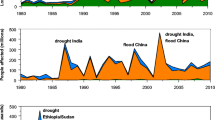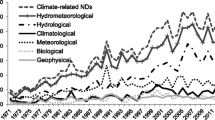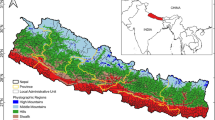Abstract
Commonly occurring natural events become natural disasters when they affect the population through death and injury, and/or through the destruction of natural and physical capital on which people rely for their livelihood and quality of life. Climate change plays a role in that it tends to increase the frequency and intensity of weather-related natural disasters. Additionally, climate change may put people at risk by influencing access to water, coastal flooding, disease and hunger, and leaving them with a more degraded environment, leading, in turn, to increased vulnerability. The purpose of this paper is to present a review and synthesis of the literature and case studies addressing differential impacts of climate change-related natural disasters on a society and its economy. Developed and developing countries show different vulnerabilities to natural disasters. Even within countries, impacts vary significantly across population and economic sectors. When losses from natural disasters are large, their cumulative effect can have notable macroeconomic impacts, which feed back to further pronounce existing income inequalities and lower income levels. Impacts tend to be most pronounced for women, the young and elderly, and people of ethnic or racial minorities.


Similar content being viewed by others
Notes
In the remainder of this paper we will not address earthquakes when discussing natural disasters because they are not related to climate change. However, they do impose a high toll of death and injury, and have similar macroeconomic implications; specific group vulnerabilities typically hold.
References
Adger, W. N. (1999). Social vulnerability to climate change and extremes in coastal Vietnam. World Development, 27(2), 249–269.
Albala-Bertrand, J. M. (1993). Political economy of large natural disasters. Oxford, UK: Clarendon Press.
Beady, C., & Bolin, R. (1986). The role of the black media in disaster reportings to the black community. Boulder, CO: Institute of Behavioral Science, University of Colorado.
Benson, C., & Clay, E. (2003). Understanding the economic and financial impacts of natural disasters. Disaster Risk Management Series No. 4, World Bank.
Benson, C., & Clay, E. (2004). Beyond the damage: Probing the economic and financial consequences of natural disasters. Presentation at ODI, May 11, 2004. http://www.odi.org.uk/speeches/disasters_2004/presentation.pdf
Benson, C., Clay, E., Michael, F. V., & Robertson, A. W. (2001). Dominica natural disasters and economic development in a small island state. Disaster Risk Management Working Paper Series No. 2. Washington DC: World Bank.
Bilsborrow, R. E. (1992). Population growth, internal migration, and environmental degradation in rural areas of developing countries. European Journal of Population/Revue européenne de Démographie, 8(2), 125–148.
Blaikie, P. M., et al. (1994). At risk: Natural hazards, people’s vulnerability, and disasters. London: Routledge.
Blum, L. N., Linda, B. B., & Michael A. W. (1998). Heat-related illness during extreme weather emergencies. Journal of the American Medical Association, 279, 1514.
Bohle, H. G., Downing, T. E., & Watts, M. J. (1994). Climate change and social vulnerability. Toward a sociology and geography of food insecurity. Global Environmental Change, 4(1), 37–48.
Bunyavanich, S., et al. (2003). The impact of climate change on child health. Ambulatory Pediatrics, 3(1), 44–52.
Cannon, T. (1994). Vulnerability analysis and the explanation of “natural” disasters. In: A Varley (Ed.), Disasters, development and environment (pp. 13–30). Chichester: Wiley.
Centre for Research on the Epidemiology of Disasters (CRED) (2004). EM-DAT: The OFA/CRES International Disaster Database. http://www.em-dat.net
Chan, N. W., & Parker, D. J. (1996). Response to dynamic flood hazard factors in Peninsular Malaysia. The Geographical Journal, 162(3), 313–325.
Chambers, R. (1989). Vulnerability, coping and policy, Institute for Development Studies (IDS). Bulletin, 20, 1–7.
Charveriat, C. (2000). Natural disasters in Latin America and the Caribbean: An overview of risk. Working Paper No. 434. Washington D.C.: Inter-American Development Bank.
Cleaver, K. M., & Schreiber, G. A. (1994). Reversing the spiral: The population, agriculture, and environment nexus in Sub-Saharan Africa. Washington D.C.: The World Bank.
Crowards, T. (2000). Comparative vulnerability of natural disasters in the Caribbean. Staff Working Paper No. 1/00. Barbados: Caribbean Development Bank.
Cubash, U., Meehl, G. A., Boer, G. J., Stouffer, R. J., Dix, M., Noda, A., Senior, C. A., Raper, S., & Yap, K. S. (2001). Projections of future climate change. In J. T. Houghton, Y. Ding, D. J. Griggs, M. Noguer, P. J. van der Linden, X. Dai, K. Maskell, & C. A. Johnson (Eds.), Climate change 2001: the scientific basis. Contributions of working group I to the third assessment report of the intergovernmental panel on climate change (pp. 525–582). Cambridge, UK: Cambridge University Press.
Cutter, S., Boruff, B., & Shirley, W. L. (2003). Social vulnerability to environmental hazards. Social Science Quarterly, 84(2), 242–261.
De Souza, R. M. (2004). In harm’s way: Hurricanes, population trends, and environmental change. Population Reference Bureau, http://www.prb.org
Deininger, K., & Squire, L. (1996). A new dataset measuring income inequality. World Bank Economic Review, 10, 565–591.
Denton, F. (2002). Climate change vulnerability, impacts, and adaptation: Why does gender matter? Gender & Development, 10(2), 10–20.
Dilley, M., Chen, R. S., Deichmann, U., Learner-Lam, A. L., & Arnold, M. (2005). Natural disaster hotspots: A global risk analysis. Disaster Risk Management Series No. 5. Washington D.C.: World Bank.
Dow, J. (1992). Uncertainty aversion, risk aversion, and the optimal choice of portfolio. Econometrica, 60, 197.
Downing, T. E., Olsthoorn, A. A., & Tol, R. S. J. (1999). Climate change and risk. London, UK US Routledge.
Easterling, D. R., Meehl, G. A., Parmesan, C., Changnon, S. A., Karl, T. R., & Mearns, L. O. (2000). Climate extremes: Observations, modeling, and impacts. Science, 289, 2068–2074.
Economic Commission for Latin America, the Inter-American Development Bank (ECLAC) (2000). A matter of development: How to reduce vulnerability in the face of natural disasters. Trinidad: Port-of-Spain.
Emanuel, K. (2005). Increasing destructiveness of tropical cyclones over the past 30 years. Nature, 436, 686–688.
Enarson, E. (2000). Gender and natural disasters. ILO in focus programme on crisis response and reconstruction. Working Paper 1, pp. 4–29.
Forsyth, T., Leach, M., & Scoones, I. (1998). Poverty and environment: Priorities for research and policy. UK: United Nations Development Programme and the European Commission, Institute of Development Studies.
Fothergill, A., Maestas, E. G. M., & Darlington, J. D. (1999). Race, ethnicity and disasters in the United States: A review of the literature. Disasters, 23(2), 156–174.
Gaiha, R., & Imai, K. (2004). Vulnerability, shocks and persistence of poverty: Estimate for semi-arid rural South India. Oxford Development Studies, 32(2), 261–281.
Gordon, L., Dunlop, M., & Foran, B. (2003). Land cover change and water vapour flows: Learning from Australia. Philosophical Transactions of the Royal Society of London B, 358, 1973–1984.
Grepperud, S. (1996). Population pressure and land degradation: The case of Ethiopia. Journal of Environmental Economics and Management, 30(1), 18–33.
Hardoy, J. E., Mitlin, D., & Satterthwaite, D. (2004). Environmental problems in an urbanizing world: Finding solutions in Africa, Asia, and Latin America. James & James/Earthscan.
Homer-Dixon, T. F. (1994). Environmental scarcities and violent conflict: Evidence from cases. International Security, 19(1), 5–40.
Intergovernmental Panel on Climate Change (IPCC) (2001). Third assessment report-climate change 2001. Geneva, Switzerland.
International Monetary Fund (IMF) (2003). Fund assistance for countries facing exogenous shocks. http://www.imf.org/external/np/pdr/sustain/2003/080803.pdf
Johnson, S. P. (1993). Earth summit: United Nations conference on environment and development, Rio de Janeiro, Brazil. Boston, MA: Brazil, Graham & Trotman/Martinus Nijhoff.
Jones, T. S., et al. (1982). Morbidity and mortality associated with the July 1980 heat wave in St. Louis and Kansas city, Mo. Journal of the American Medical Association, 247(24), 3327–3331.
Kahn, M. (2005). The death toll from natural disasters: The role of income, geography and institutions. Review of Economics and Statistics, 87(2), 271–284.
Kelly, P. M., & Adger, W. N. (2000). Theory and practice in assessing vulnerability to climate change and facilitating adaptation. Climate Change, 47, 325–352.
Kilbourne, E. M., et al. (1982). Risk factors for heatstroke. Journal of the American Medical Association, 247(24), 3332–3336.
Langer, N. (2004). Natural disasters that reveal cracks in our social foundation. Educational Gerontology, 30, 275–285.
Lavell, A. (1994). Prevention and mitigation of disasters in Central America: Vulnerability to disasters at the local level. In: A. Varley (Ed.), Disasters, development and environment (pp. 49–63). Chichester: John Wiley and Sons.
Lonergan, S. (1998). The role of environmental degradation in population displacement, environmental change and security project report. Issue 4, pp. 5–15.
Lustig, N. (2000). Crisis and the poor: Socially responsible macroeconomics. Economia, 1(1), 1–30.
Martine, G, & Guzman, J. M. (2002). Population, poverty, and vulnerability: Mitigating the effects of natural disasters. ECSP Report, Issue 8, pp. 45–68.
McGeehin, M. A., & Mirabelli, M. (2001). The potential impacts of climate variability and change on temperature-related morbidity and mortality in the United States. Environmental Health Perspectives, 109(2), 185–189.
Meadows, M. E., & Hoffman T. M. (2003). Land degradation and climate change in South Africa. The Geographical Journal, 169(2), 68–177.
Mink, S. D. (1993). Poverty, population and the environment. World Bank Discussion Paper No 189. Washington D.C.: The World Bank.
Ngo, E. (2001). When disasters and age collide: Reviewing vulnerability of the elderly. Natural Hazards Review, 2(2), 80–89.
O’Brien, K., & Leichenko, R. (2000). Double exposure: Assessing the impacts of climate change within the context of economic globalization. Global Environmental Change, 10(3), 221–232.
OECD (2003). Analysing the nexus of sustainable development and climate change: An overview. Paris: OECD.
Pelling, M. (1997). What determines vulnerability to floods; A case study in Georgetown, Guyana. Environment and Urbanization, 9(1), 203–226.
Rashid, S. F. (2000). The urban poor in Dhaka City: Their struggles and coping strategies during the floods of 1998. Disasters, 24(3), 240–253.
Rasmussen, T.N. (2004). Macroeconomic implications of natural disasters in the Caribbean. IMF Working Paper WP/04/224.
Rayner, S., & Malone, E. (2001). Climate change, poverty, and intragenerational equity: The national level. International Journal of Global Environmental Issues, 1(2), 175–202.
Reardon T., & Taylor J. E. (1996). Agroclimatic shock, income inequality, and poverty: Evidence from Burkina Faso. World Development, 24(5), 901–914.
Ruth, M. (Ed.) (2006). Smart growth and climate change: Regional development, infrastructure and adaptation. Cheltenham, England: Edward Elgar Publishers.
Scheraga, J. D., & Grambsch, A. E. (1998). Risks, opportunities, and adaptation to climate change. Climate Research, 10, 85–95.
Scherr S. J. (2000). A downward spiral? Research evidence on the relationship between poverty and natural resource degradation. Food Policy, 25, 479–498.
Schroeder, R. A. (1987). Gender vulnerability to drought: A case study of the Hausa Social Environment. Natural Hazard Research, Working Paper 58, pp. 35–41.
Semenza, J. C., et al. (1996). Heat-related deaths during the July 1995 heat wave in Chicago. The New England Journal of Medicine, 35, 84–90.
Trenberth, K. E. (2005). Uncertainty in hurricanes and global warming. Science, 308, 1036–1039.
UNDP (1995). Human development report, gender and human development, United Nations Development Program. New York, NY: United Nations.
Vaux, T., & Lund, F. (2003). Working women and security: Self Employed Women’s Association’s response to crisis. Journal of Human Development, 4(2), 265.
Webster, P. J., Holland, G. J., Curry, J. A., & Chang, H. R. (2005). Changes in tropical cyclone number, duration, and intensity in a warming environment. Science, 309(5742), 1844–1846.
Winchester, P. (2000). Cyclone mitigation, resource allocation and post-disaster reconstruction in South India: Lessons from two decades of research. Disasters, 24(1), 18–37.
Winchester, S. (2003). Krakatoa. The day the world exploded: August 27, 1883. New York: HarperCollins.
Wisner, B. (1997). Environmental health and safety in urban South Africa. In: B. Johnston (Ed.), Life and death matters (pp. 265–286). Walnut Creek, CA: Altamira.
World Bank (2003). Caribbean Economic Overview 2002: Macroeconomic volatility, household vulnerability, and institutional policy responses. Report No. 24165-LAC, Washington, DC.
Acknowledgements
We thank Haewon Chon, Dana Coelho and Julia Miller for their contributions. This research was partially funded by Universidad de las Américas, Puebla, Universidad Iberoamericana Puebla, and the Roy F. Weston Chair in Natural Economics at the School of Public Policy, University of Maryland. We also thank two anonymous referees for their helpful comments.
Author information
Authors and Affiliations
Corresponding author
Additional information
Readers should send their comments on this paper to: BhaskarNath@aol.com within 3 months of publication of this issue.
Appendices
Rights and permissions
About this article
Cite this article
Ibarrarán, M.E., Ruth, M., Ahmad, S. et al. Climate change and natural disasters: macroeconomic performance and distributional impacts. Environ Dev Sustain 11, 549–569 (2009). https://doi.org/10.1007/s10668-007-9129-9
Received:
Accepted:
Published:
Issue Date:
DOI: https://doi.org/10.1007/s10668-007-9129-9




